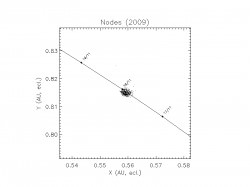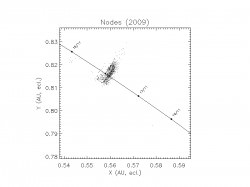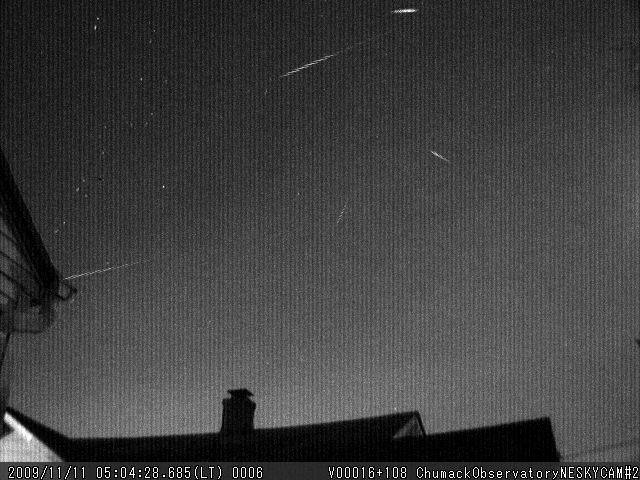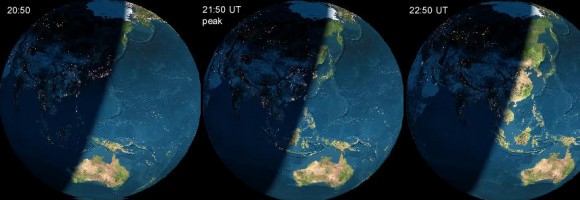The annual Leonid Meteor Shower is about to light up the night… And the time to start watching is now. The year 2009 will not see a Leonid storm, but an outburst for sure. There are still some uncertainties regarding the time of maximum of the 1466 trail. For those of you seeking a definitive date and time, it isn’t always possible, but we can learn a whole lot about when and where to look.
The Leonid Meteor Shower belongs to the debris shed by comet 55/P Tempel-Tuttle as it passes our Sun in its 33.2 year orbit. Although it was once assumed it would simply be about 33 years between the heaviest “showers,” we later came to realize the debris formed a cloud which lagged behind the comet and dispersed irregularly. With each successive pass of Tempel-Tuttle, new filaments of debris are left in space along with the old ones, creating different “streams” the orbiting Earth passes through at varying times, which makes blanket predictions unreliable at best. Each year during November, we pass through the filaments of its debris – both old and new ones – and the chances of impacting a particular stream from any one particular year of Tempel-Tuttle’s orbit becomes a matter of mathematical estimates. We know when it passed… We know where it passed… But will we encounter it and to what degree? Traditional dates for the peak of the Leonid meteor shower occur as early as the morning of November 17 and as late as November 19.
So what can we expect this year? According to NASA’s 2009 predictions a significant shower is expected this year when Earth crosses the 1466-dust and 1533-dust ejecta of comet 55P/Tempel-Tuttle. According to J. Vaubaillon, the narrow (about 1-hr) shower is expected to peak on November 17, 2009, at 21:43 (1466) and 21:50 (1533) UT, perhaps 0.5 to 1.0 hour later based on a mis-match in 2008, with rates peaking at about ZHR = 115 + 80 = 195/hr (scaled to rates observed in 2008). E. Lyytinen, M. Maslov, D. Moser, and M. Sato all predict similar activity from both trails, combining to about ZHR = 150 – 300 /hr. P. Jenniskens notes that if the calculated trail pattern is slightly shifted in the same manner as observed before, then the 1533-dust trail would move in Earth’s path and its rates would be higher (the 1466-dust trail would move away). However, the 1533-dust trail is distorted in the models, and because of that it is not clear how much higher that would be. This remains a rare opportunity to study old dust trails from comet 55P/Tempel-Tuttle. In such old trails, the model of Lyytinen and Nissinen predicts wide trails, which can be tested by measuring the width of the outburst profile.
 Let’s take a closer look at the at how the two centuries old trails will affect our observing, beginning with the one created in the year 1466. The exact same trail will be encountered again this year with its maximum rate of up to 115 meteors per hour occurring at 21:43 UT (may be 0.5-1hr later). “The trail will be much closer to the Earth, explaining why we expect a quite high zenith hourly rate.” say J. Vaubaillon (et al), “However the discrepancy between the expected time of maximum remains, as well as a general higher expected ZHR. Among the possible explanations are: sensitivity to initial conditions (given that the trail is 16 Rev. old) or change of cometary activity (impossible to verify unfortunately).”
Let’s take a closer look at the at how the two centuries old trails will affect our observing, beginning with the one created in the year 1466. The exact same trail will be encountered again this year with its maximum rate of up to 115 meteors per hour occurring at 21:43 UT (may be 0.5-1hr later). “The trail will be much closer to the Earth, explaining why we expect a quite high zenith hourly rate.” say J. Vaubaillon (et al), “However the discrepancy between the expected time of maximum remains, as well as a general higher expected ZHR. Among the possible explanations are: sensitivity to initial conditions (given that the trail is 16 Rev. old) or change of cometary activity (impossible to verify unfortunately).”
 But don’t count on only this single trail, because the year 1533 trail will encounter the Earth at almost the same time as the 1466 trail. Its maximum time of arrival is expected to be at 21:50 UT on the 17th of November, with a zenith hourly rate of 80 – for a combined rate of perhaps 200 meteors per hour. “The total level of the shower (ZHR~200/hr) was callibrated using the 2008 observations of the 1466 trail, but nothing is known from the 1533 trail. As a consequence, it will be very interesting to check.” comments Vaubaillon, “In particular there might be a difference of up to 1 hour between the 1466 and 1533 trail, or they might even be late together, giving us some insight about how well/poorly we know comet 55P’s orbit.”
But don’t count on only this single trail, because the year 1533 trail will encounter the Earth at almost the same time as the 1466 trail. Its maximum time of arrival is expected to be at 21:50 UT on the 17th of November, with a zenith hourly rate of 80 – for a combined rate of perhaps 200 meteors per hour. “The total level of the shower (ZHR~200/hr) was callibrated using the 2008 observations of the 1466 trail, but nothing is known from the 1533 trail. As a consequence, it will be very interesting to check.” comments Vaubaillon, “In particular there might be a difference of up to 1 hour between the 1466 and 1533 trail, or they might even be late together, giving us some insight about how well/poorly we know comet 55P’s orbit.”
Let’s take a closer look with 3D-view of the two trails may have evolved between 1466 and 2009…
Dr. Vaubaillon’s colleagues from MSFC (D. Moser and B. Cooke) pointed out that the best location to view the outburst caused by the 1466 and 1533 trails will be centered around India and includes: Nepal, Thailand, Western China, Tadjikistan, Afghanistan, Eastern Iran, South Central Russia, etc. Dr. P. Atreya (IMCCE), citizen of Nepal, is currently organizing an international Leonid observation campaign in his home country. This campaign will involve many amateurs and researchers from Nepal and other countries. The climate conditions in Nepal at this time of the year makes it an excellent spot.
We may never know precisely where and when the Leonids might strike, but we do know that a good time to look for this activity is well before dawn on November 17, 18 and 19. Where do you look? For most of us, the best position will be to face east and look overhead. With the Moon out of the picture, even if you don’t see a huge amount of meteoric activity, chances are that even a few minutes of your time will bring a bright and happy reward!
Many thanks to John Chumack for sharing his early 2009 Leonid image and to NASA, Dr. Vaubaillon and colleagues for the illustrations and 3D animation!



Another good review, thanks for that.
I would just like to add that there is a link to a Far East live Leonids show on http://www.roselandobservatory.com
thanks for the link, brian!
ohio has been in and out of the clouds for the last two mornings in a row… but not so bad that i haven’t had a chance to observe!
the 17th saw bright and fast meteor activity, with about 12 per hour. the 18th had far fewer bright meteors, but sported tremendous rounds of faint flurries centered around an area approximately RA 10h 46m 50s – Dec 24° 38′ 56″. these came in around magnitude 4 and in groups of up to 10 or more per minute.
too kewl!